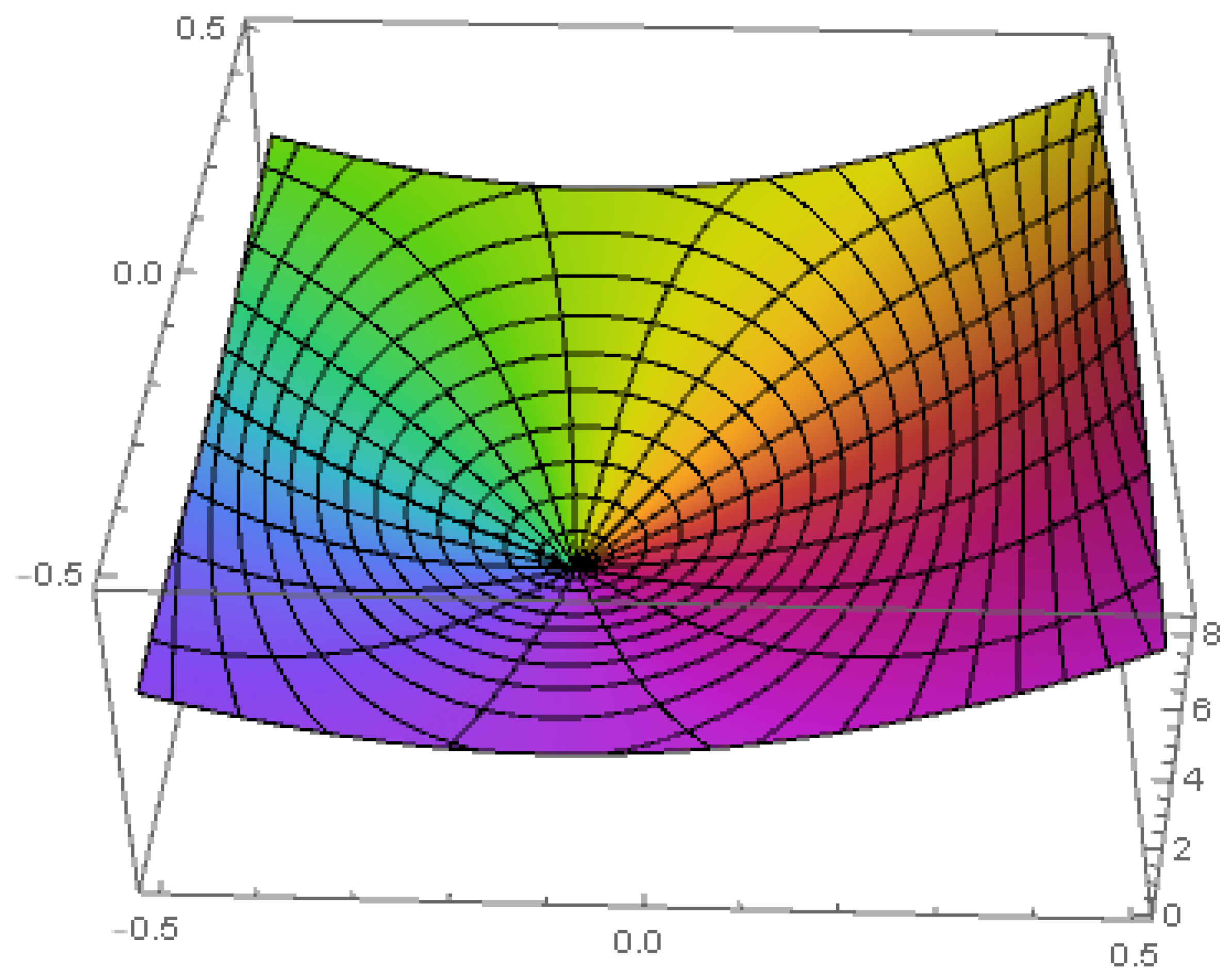Specific Classes of Analytic Functions Communicated with a Q-Differential Operator Including a Generalized Hypergeometic Function
Abstract
:1. Introduction
2. Fractional Operators
Modified Operators
3. Quantum Formula
- is also convex of order ϱ.
- It achieves the next upper and lower bounds
- and its derivative achieves the next upper and lower bounds
- The above results are sharp such that the maximum function is given by the formula (see Figure 1)
- LetIf and are a convex of order ϱ, then is convex of order where
- is also starlike of order ϱ.
- It achieves the next upper and lower bounds
- and its derivative achieves the next upper and lower bounds
- The above results are sharp such that the maximum function is given by the formula (see Figure 2)
- If and are starlike of order ϱ then is starlike of order where
4. Differential Inequalities
5. Conclusions
Author Contributions
Funding
Institutional Review Board Statement
Informed Consent Statement
Data Availability Statement
Conflicts of Interest
References
- Jackson, F.H. q-form of Taylor’s theorem. Messenger Math. 1909, 38, 62–64. [Google Scholar]
- Exton, H. Q-Hypergeometric Functions and Applications; John Wiley & Sons, Inc.: New York, NY, USA, 1983; Volume 355. [Google Scholar]
- Celeghini, E.; Demartino, S.; Desiena, S.; Rasetti, M.; Vitiello, G. Quantum groups, coherent states, squeezing and lattice quantum mechanics. Ann. Phys. 1995, 241, 50–67. [Google Scholar] [CrossRef]
- Biedenharn, L.C. The quantum group SUq (2) and a q-analogue of the boson operators. J. Phys. A Math. Gen. 1989, 22, L873. [Google Scholar] [CrossRef]
- Ohnuki, Y.; Susumu, K. Quantum Field Theory and Parastatistics; University of Tokyo Press: Tokyo, Japan, 1982; pp. 100–110. [Google Scholar]
- Zirar, H. Some applications of fractional calculus operators to a certain subclass of analytic functions defined by integral operator involving generalized Hypergeometric function. Gen. Math. Notes 2016, 35, 19–35. [Google Scholar]
- Hadid, S.B.; Ibrahim, R.W.; Shaher, M. Multivalent functions and differential operator extended by the quantum calculus. Fractal Fract. 2022, 6, 354. [Google Scholar] [CrossRef]
- Arfaoui, S.; Maryam, G.A.; Ben, M.A. Quantum wavelet uncertainty principle. Fractal Fract. 2021, 6, 8. [Google Scholar] [CrossRef]
- Aldawish, I.; Ibrahim, R.W. Solvability of a new q-differential equation related to q-differential inequality of a special type of analytic functions. Fractal Fract. 2021, 5, 228. [Google Scholar] [CrossRef]
- Pishkoo, A.; Darus, M. On Meijer’s G-Functions (MGFs) and its applications. Rev. Theor. Sci. 2015, 3, 216–223. [Google Scholar] [CrossRef]
- Prabhakar, T.R. A singular integral equation with a generalized Mittag-Leffler function in the kernel. Yokohama Math. J. 1971, 19, 7–15. [Google Scholar]
- Garra, R.; Rudolf, G.; Federico, P.; Zivorad, T. Hilfer-Prabhakar derivatives and some applications. App. Math. Comp. 2014, 242, 576–589. [Google Scholar] [CrossRef]
- Garra, R.; Roberto, G. The Prabhakar or three parameter Mittag-Leffler function: Theory and application. Commun. Nonlinear Sci. Numer. Simul. 2018, 56, 314–329. [Google Scholar] [CrossRef]
- Giusti, A.; Ivano, C. Prabhakar-like fractional viscoelasticity. Commun. Nonlinear Sci. Numer. Simul. 2018, 56, 138–143. [Google Scholar] [CrossRef]
- Derakhshan, M.H. New numerical algorithm to solve variable-order fractional integrodifferential equations in the sense of Hilfer-Prabhakar derivative. Abstr. Appl. Anal. 2021, 2021, 1–10. [Google Scholar] [CrossRef]
- Eshaghi, S.; Alireza, A.; Reza, K.G. Generalized Mittag-Leffler stability of nonlinear fractional regularized Prabhakar differential systems. Int. J. Nonlinear Anal. Appl. 2021, 12, 665–678. [Google Scholar]
- Eghbali, N.; Aram, M.; Rassias, J. Mittag-Leffler-Hyers-Ulam stability of Prabhakar fractional integral equation. Int. J. Nonlinear Anal. Appl. 2021, 12, 25–33. [Google Scholar]
- Michelitsch, T.M.; Federico, P.; Alejandro, P.R. On discrete time Prabhakar-generalized fractional Poisson processes and related stochastic dynamics. Phys. A Stat. Mech. Appl. 2021, 565, 125541. [Google Scholar] [CrossRef]
- Kilbas, A.A.; Megumi, S.; Saxena, R.K. Generalized Mittag-Leffler function and generalized fractional calculus operators. Integral Transform. Spec. Funct. 2004, 15, 31–49. [Google Scholar] [CrossRef]
- Chen, M.P. On a class of starlike functions. Nanta Math. 1975, 8, 79–82. [Google Scholar]
- Sharma, S.K.; Jain, R. On some properties of generalized q-Mittag Leffler function. Math. Aeterna 2014, 4, 613–619. [Google Scholar]
- Srivastava, H.M.; Owa, S.; Chatterjea, S.K. A note on certain classes of starlike functions. Rend. Semin. Mat. Univ. Padova 1987, 77, 115–124. [Google Scholar]
- Miller, S.S.; Mocanu, P.T. Differential Subordinations. In Theory and Applications; Marcel Dekker Inc.: New York, NY, USA; Basel, Switzerland, 2000. [Google Scholar]
- Campbell, D.M. Majorization-subordination theorems for locally univalent functions, II. Canad. J. Math. 1973, 25, 420–425. [Google Scholar] [CrossRef]



Publisher’s Note: MDPI stays neutral with regard to jurisdictional claims in published maps and institutional affiliations. |
© 2022 by the authors. Licensee MDPI, Basel, Switzerland. This article is an open access article distributed under the terms and conditions of the Creative Commons Attribution (CC BY) license (https://creativecommons.org/licenses/by/4.0/).
Share and Cite
Alarifi, N.M.; Ibrahim, R.W. Specific Classes of Analytic Functions Communicated with a Q-Differential Operator Including a Generalized Hypergeometic Function. Fractal Fract. 2022, 6, 545. https://doi.org/10.3390/fractalfract6100545
Alarifi NM, Ibrahim RW. Specific Classes of Analytic Functions Communicated with a Q-Differential Operator Including a Generalized Hypergeometic Function. Fractal and Fractional. 2022; 6(10):545. https://doi.org/10.3390/fractalfract6100545
Chicago/Turabian StyleAlarifi, Najla M., and Rabha W. Ibrahim. 2022. "Specific Classes of Analytic Functions Communicated with a Q-Differential Operator Including a Generalized Hypergeometic Function" Fractal and Fractional 6, no. 10: 545. https://doi.org/10.3390/fractalfract6100545
APA StyleAlarifi, N. M., & Ibrahim, R. W. (2022). Specific Classes of Analytic Functions Communicated with a Q-Differential Operator Including a Generalized Hypergeometic Function. Fractal and Fractional, 6(10), 545. https://doi.org/10.3390/fractalfract6100545







